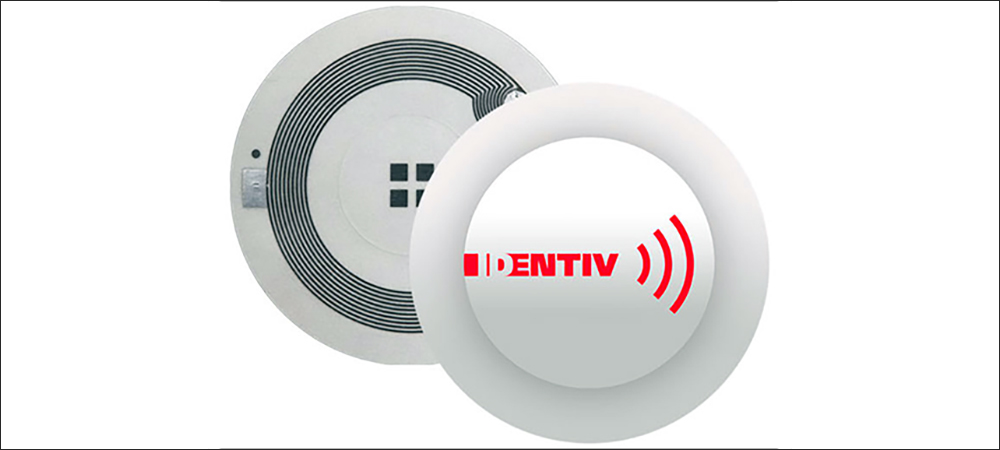Approximately a dozen companies and government agencies are currently sampling a new temperature-monitoring patch from physical security and identification technology company Identiv. The system provides a user’s temperature via an app, with the tap of a smartphone. The Near Field Communication (NFC)-enabled Body Temperature Measurement Patch includes an NXP Semiconductors NTAG NHS Smart sensor chip, as well as an antenna, so that it can collect the temperature of an individual wearing the patch, then forward that data when interrogated by an NFC-enabled smartphone or other reading device.
Sample versions are being tested by entities representing three sectors, according to Manfred Mueller, Identiv’s COO and GM: federal governments, healthcare device manufacturers and systems integrators developing solutions for stadiums and other large public venues. The solution, designed to allow users to capture their own temperature readings wirelessly, consists of a patch that adheres directly to a person’s arm. Via a tag reader app on the user’s phone, an NDEF message is transferred which, in the current demo application, routes to an NXP server that then displays a website on the phone, along with the measured temperature.

Identiv is also developing a new version of an app that will be released within the next few weeks, the company reports. The technology is designed to offer an alternative to temperature readers installed at gates, which are not always precise, or handheld thermal devices that can scan individuals entering a restricted space. It would make temperature collection not only more accurate, Mueller says, but faster and less intrusive.
The patch is designed to wrap around a person’s upper arm, with the temperature sensor located near the armpit and the read point on the front of the arm. It comes with a non-irritant adhesive and can be attached like a Band-Aid bandage. The patch could potentially remain on the individual’s arm for several days or a week in its passive form, while in some cases users would only need to utilize it during a single event, such as when being admitted at a stadium’s entrance. “You simply tap on the antenna and it spits out the temperature,” Mueller explains. It has a temperature accuracy of about 0.3 degrees Celsius.
With regard to government adoption, the system could be used by health departments, for instance, to track the temperatures of quarantined individuals. If a person were to enter a country in which quarantining were mandated, he or she would be provided with a patch and instructed to download an app. The individual could then apply the patch and use his or her phone to access temperature readings at periodic times, such as once a day, so that the health department could monitor the person’s health.
The phone would typically need to be tapped within a few centimeters of the patch antenna on the arm in order to capture that data. Because the temperature data is automatically linked with the individual who downloads the app, a health office or other interested party could know when that individual may show symptoms of COVID-19 and man thus need to be visited or instructed to report to a hospital. Additionally, if the results indicated that person to be fever-free for a specified number of days, the health agency could determine that she or he met the quarantine requirements and can be released into the public.
Pharmaceutical and device manufacturers are also testing the technology to build into their own products. “Their innovation, engineering and business teams have reached out to us,” Mueller states, “and they are now evaluating the product.” If these companies developed a system for healthcare providers, the technology would make it possible for a patient home with a fever, or who has been exposed to COVID-19, to upload temperature data on a daily basis via the app so that the healthcare provider could view how that person was managing with the disease, based on the temperature information.
Systems integrators are also testing the technology for solutions at theme parks, cruise ships and stadiums, Mueller reports. In this third use case, individuals could buy a ticket to a sporting event, music festival or other venue, then receive that ticket and a temperature patch prior to attending. He or she would download an app from the venue and attach the patch to a bare arm before entering the facility. At the entrance, the person could tap his or her phone against the patch and show the resultant reading to a staff member at the entrance. Alternatively, the gate employee could read each individual’s patch using an official reader before determining whether or not to admit him or her.
The initial product release is a battery-free passive patch, meaning it will only send immediate temperature readings at the time the patch is being interrogated. However, Mueller says, the company is also developing an active datalogger version that would come with a battery. “You could log the temperature over the course of a day or a week,” he states.
Users could set periodic intervals at which temperature data could be collected, measured and stored, and all of that information would then be uploaded once the phone was tapped near the patch. In that way, for instance, doctors could view the trends of a patient’s temperature levels throughout a day or week. The patch’s battery could provide that data for a week or more, depending on the frequency of temperature readings the system was set to measure and store.
In some cases, Mueller says, device manufacturers or other users might require a medical-grade-certified version of the sensor. That version of the patch is available as well, he adds, though at a higher price. Identiv would include the high-accuracy temperature sensor following the ASTM E1112 standard for electronic thermometers for intermittent determination of patient temperature. The adhesive used could vary depending on the particular use case, Mueller explains. Badges intended to be worn for multiple days may need to be water-resistant, while others could be intended for only a single use.
In addition, the company is testing versions of the patch that might be attached to other parts of the body, for use cases in which a patch in the upper arm might not be convenient—for example, with environments in which users might wear jackets or other clothing over the arm. Identiv is developing an app for consumer use, though it expects systems integrators and device manufacturers to create their own apps.
The solution could have many use cases beyond COVD-19 transmission management, Mueller predicts. In the meantime, he expects the system to make it simpler for organizations to test individuals for a fever before they are permitted to enter any facility, thereby reducing the spread of infection. “It’s not very convenient if you have somebody hold that temperature measurement gun in your face,” he states. “This is just another way to do it in a more convenient way.”
The company’s goal, according to Mueller, is to simplify the transition into a post-COVID-19 world in which wellness can be more easily monitored. “I think that we, like the rest of the world, are focused on reopening, on getting back to living,” he says. “Yet at the same time, there is still this fear of the unknown and the potential for future spikes in COVID-19 cases.” The patch, the company hopes, will ease “the process of monitoring others, and doing all of this without skipping a beat in the things we have to move through in our everyday lives.”


